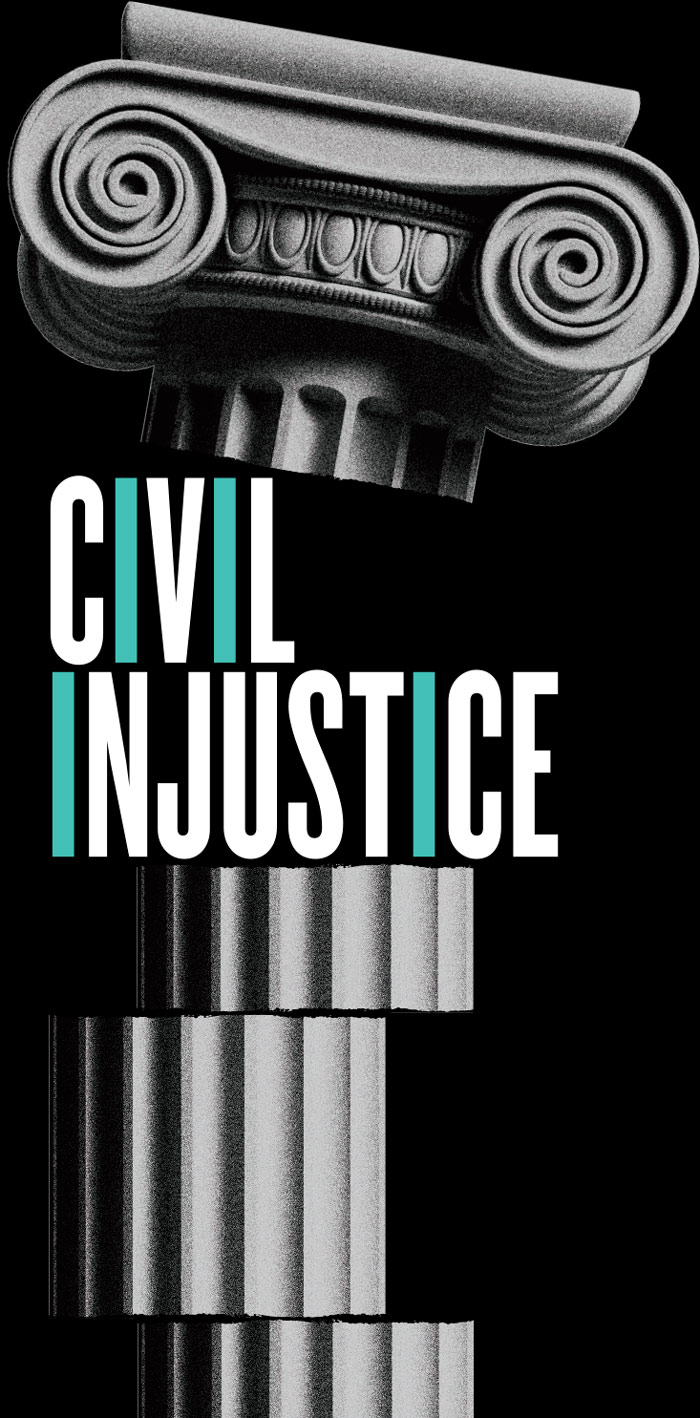Civil Injustice

By Larry Teitelbaum
Civil Injustice

By Larry Teitelbaum
It is not a matter of poor and middle-income people and small business owners falling through the cracks; the chasm is more like a sinkhole — a situation that Jim Sandman L’76, Distinguished Lecturer and Senior Consultant to The Future of the Profession Initiative (FPI) at the University of Pennsylvania Carey Law School, finds intolerable. He is deeply disturbed by how far the country has strayed from the promise of justice for all.
For years, he led Arnold & Porter, one of the most storied law firms in America, and lived and worked at the center of power in Washington, D.C., where he counseled corporate power brokers, oversaw the influential District of Columbia Bar, and sat on important law committees. Yet, by his own account, he had no idea how broken the civil justice system had become in America, calling it an “invisible” issue that eludes the attention of most Americans and most lawyers.
Then he became President of the Legal Services Corporation (LSC), the largest funder of civil legal aid programs in the United States, and he quickly realized the magnitude of the problem. Today, he advocates for root and branch reform of the civil legal system.
Despite an abundance of lawyers in America, the U.S. ranks 126th out of 139 countries in access to and affordability of civil justice, according to the World Justice Project.
The situation is so stark that a University of Toronto professor (Canada ranks 65th in the above category) estimates that every licensed lawyer in America could do 180 hours of pro bono work every year (on average, U.S. lawyers do approximately 60 hours a year) and still only provide one hour of assistance to every person in need.
“To me, it’s a threat to the rule of law to have a system that is so badly failing tens of millions of Americans every year,” Sandman said. “When you persistently have such a significant disparity between need, demand, and supply, something’s wrong. And when that happens in a regulated market, you need to ask whether regulation is causing the dysfunction or at least contributing to it.”
A year and a half ago, Sandman lent his weight to the FPI, which is driving discussion on innovation in the world of law.
In an advisory capacity, the American Bar Association (ABA) is keen on tracking reform efforts around the country and evaluating their effectiveness through its Center for Innovation, which is developing uniform state metrics and an online clearinghouse that will offer a variety of expert perspectives on reform.
Traditionally, states mostly adhere to the ABA’s Model Rules of Professional Conduct which prohibit nonlawyer ownership of legal practices and the sharing of legal fees with nonlawyers. But these are not binding, and states can choose to set their own standards, guided by their highest courts or legislatures.
Indeed, recent years have seen a coast-to-coast churn on the reform front. At least 15 states have considered or implemented reforms (see chart), with Utah and Arizona leading the way.

One State’s Early Experience with Reform
orrowing a concept from the financial services industry, Utah is the first state to create a regulatory sandbox, in which an administrative body (in this case, the Utah Supreme Court) oversees experimentation in a regulated marketplace.
In 2018, the state collected data showing that in 93 percent of all civil and family law disputes in the adult courts in the state’s most populous area, at least one litigant was unrepresented, exceeding already high national numbers. Recognizing the need to expand access to justice given these and other statistics, Utah established a statewide pro bono system, permitted licensed paralegal professionals to deliver legal services in debt collection cases, landlord/tenant cases, and family law matters, and piloted an online dispute resolution system in Small Claims Court.
Significantly, the state also put in motion, at the direction of the Utah Bar Association, a work group to study and recommend changes to the regulatory structure. The group, which was co-chaired by Utah Supreme Court Justice Deno Himonas and then-Utah Bar President John Lund, recommended the Utah Supreme Court establish the regulatory sandbox and a new Office of Legal Services Innovation to test new models of service delivery, monitor new practitioners, and field consumer complaints. The Court unanimously agreed with the recommendation.
Some of the models include software providers teaming with lawyers, debt negotiation experts offering legal assistance, attorneys schooled in divorce proceedings providing a self-help tech platform to clients, and domestic violence advocates offering limited legal advice to people seeking protective orders.
Last April, the Utah Supreme Court voted unanimously to extend the initial two-year trial period by five years through the end of 2027. As of November, the Office of Legal Services Innovation had authorized 32 entities to offer alternative legal services. To date, the state says there have been no reports of significant consumer harm.
As a clerk to Justice Himonas, Bridget Lavender L’21, SPP’21 is new to Utah but not to the civil law problems in other parts of the country. The North Carolina native spent her 1L summer working with the Homeless Advocacy Project in Philadelphia. She visited soup kitchens and transitional housing sites to help people with legal issues.
“A lot of homeless people don’t know they have legal needs,” Lavender said. “Many need a copy of their birth certificate in order to apply for Social Security benefits.”
Lavender applied for a clerkship with Justice Himonas (who stepped down from the bench on March 1), after being inspired by his presentation on reform for Sandman’s “Professional Responsibility” class. As his clerk, Lavender has seen firsthand the role of state supreme courts in regulating the legal profession and pioneering reform and innovation. She hopes to draw on her experience to collaborate with the Justice and his other clerks on a law review article describing the access to justice gap and Utah’s efforts to address it.
Meanwhile, Lavender, who started her clerkship in August, has pointed things to say about the state of civil justice in America. She believes that many of the legal problems — employment disputes, custody issues, and public benefits — that she assisted people with as a Penn Law extern in Philadelphia should not require a lawyer.
“There are many social workers and paralegals who can give much better advice than I would on several issues,” she said. “But they’re prohibited from giving this advice in many states, because it’s seen as the unauthorized practice of law.”
In Utah, the most dramatic reform has been the state’s opening of law firm ownership to nonlawyers which, depending on your point of view, is either a major breakthrough that promises to provide affordable legal services to more people or a catastrophic breach of conduct that poses perils for lawyers and their clients as newcomers to the profession operate outside of ABA ethical norms.
The first entity to take advantage of the relaxation of restrictions on nonlawyer-owned law firms is Law on Call — the first law firm in the United States wholly owned by nonlawyers through a Spokane, Washington-based company named Northwest Registered Agent, which provides registered agent and corporate filing services, including free legal forms and assistance setting up LLCs, in all 50 states.
According to a news release at the time of its formation last March, clients pay $9 a month for unlimited access to licensed in-state lawyers and $100 an hour, with no retainer, should they need serious legal help. Since its inception, the firm has provided legal assistance to at least 100 clients, primarily small businesses, according to the Office of Legal Services Innovation.
The emergence of Law on Call and the prospect of similar operations around the country is a flashpoint for past-President of the New York State Bar Association and state delegate to the ABA Stephen Younger, who maintains that he is representative of a strong contingent of rank-and-file lawyers and ABA members who oppose some of the measures being proposed, especially nonlawyer ownership.













































Alternative legal practitioners, he said, tend to be wealth advisors, accounting firms, tax and estate planners and other organizations that want to make money off the legal profession.
“There’s been no proof in Arizona and Utah that this — [reform] — has done anything to help access to justice problems,” Younger said, though he looks forward to data.
Younger said he’s not opposed to reform. Like Sandman, he’s concerned about the lack of access – but wants to make sure reform is done properly and addresses the problem. He supported the New York City Council’s “Right to Counsel” legislation that provides free legal representation in eviction cases — a move that increased representation in Housing Court from 1 percent to 40 percent last year.
He also recommends licensing more para-professionals.
“I think that the legal profession underutilizes paralegals … We should be using our paralegals way more than we do, under the supervision of a lawyer,” Younger emphasized.
There are more than 300,000 paralegals in the country, according to the U.S. Bureau of Labor, though it is difficult to track the number of paralegals — who prepare reports, conduct research, and draft contracts, among other duties — because they are unlicensed.
The first paralegal training school in the country was founded in 1970 by two Penn Law graduates, Dan Promislo L’66 and Paul Shapiro C’64, L’67. Shapiro said he has an open mind about permitting paralegal professionals to work independently and provide direct legal advice to consumers, but he’s skeptical of their current qualifications to do so.
“I think it’s really hard to think of them as standalones. I’m just not sure that their training takes them to the level of performing actual legal services,” Shapiro said, citing the complexity of the law.
Sandman is much less reticent. He said Arizona and Utah have allowed paralegals to provide legal advice on their own, in prescribed areas, subject to strict education and supervised practice prerequisites. He says there are simply not enough lawyers available to supervise licensed, qualified paralegals and attend to huge unmet need. He supports limiting their substantive areas of practice as well as the tasks they can perform.
He is convinced that, just like nurses, physician assistants, and medical technicians do in healthcare, paralegals can deliver “competent, ethical” legal services without being members of the bar or having three years of legal training, especially in a crisis when there’s not enough help to go around.
Technology and Reform
any believe technology is part of the solution.
To Miguel Willis, FPI’s Inaugural Innovator in Residence, legal reform is about digital transformation, or the development of more efficient systems.
Willis brought his Access to Justice Tech Fellowship Program to the Law School and is co-teaching a spring semester course with Claudia Johnson L’97 of Pro Bono Net on how to leverage and design technology to reach more people in need.
In an interview, he talked about advances such as court form templates that free up lawyers for more complex work, automated processes to handle traffic citations and uncontested divorces to reduce court backlogs, and chat boxes in which people submit a legal problem and are directed to the right resource.
“I think technology is only half of the equation. It’s bringing those tools and solutions to people who need it most,” Willis said.
He understands the challenge well from his experience with Justice For All, a pilot program aimed at bridging legal gaps in Alaska, the most remote state in the country.
Willis spent two years with the project and just like Alaska residents, he grappled with hazardous weather and an inadequate highway system as he traveled to visit hard-to-reach areas. He talked to a range of potential providers, including nurses and librarians, to develop what has been described as a legal ecosystem. He then created a social network map identifying every legal, medical, and information systems organization in the state.
This literal road map served as part of the impetus for the Legal Navigator, an online information provider and referral system that helps people with family and housing problems find the right resources. (Alaska and Hawaii are the only states in the country with Legal Navigator managed by LSC — New York has its own system.)
Legal Navigator users click on a specific area of civil law, answer a few screening questions and a guided assistant directs them to links to appropriate legal organizations. The system is still in the beta phase, according to Willis, who added, “Having adequate access to justice, to legal systems is a central part of a thriving democracy.”
Sanjay Kamlani L’94 also knows his way around technology. He started his career at PricewaterhouseCoopers, where he counseled companies on doing business in India.
He later co-founded a company called Pangea3, which outsourced legal work from the United States to India. He and his then-partner, David Perla C’91, L’94, employed Indian lawyers to perform basic but important legal work such as electronic discovery, drafting of contracts, compliance research, and patent applications and analytics — at dramatically lower costs, according to Kamlani.
Speaking like an entrepreneur (more recently, Kamlani launched Maker5, which develops software, offers innovation advisory services to companies, and creates spin-off technology businesses), Kamlani urges the legal profession to drop some of the barriers to participation so there’s more investment in technology — one key to reducing the costs of lawyering.
Kamlani said bar regulations are preventing lawyers and law firms from effectively competing in the marketplace, investing in the future, and providing services to more people.
“A corporate business, today, can go raise $20 million to build a new solution that automates contracts and delivers contracts online,” Kamlani said. “The law firm can’t raise that money. Why does that make any sense?”
Other Routes to Legal Reform
ome propose sweeping action at the highest levels of government and the judiciary to fix the civil law problem.
Practice Professor of Law Lou Rulli is a prominent member of the public interest community in Philadelphia. The former Executive Director of the local Community Legal Services, Rulli led the Law School’s Howard Gittis Center for Clinical Legal Studies and now heads the Civil Practice and Legislative clinics.
In the Civil Practice Clinic, Rulli said he and his students have seen too much unnecessary suffering, with 80-year-old grandmothers losing their homes after their children or grandchildren have been charged with minor drug offenses. These elderly women, who lack an attorney, “have no idea what civil forfeiture is. They have no idea what the defenses are, so they waive defenses that they’re entitled to present in court that go directly to the merits of the case,” Rulli said.

Younger, a Partner in Foley Hoag’s Litigation department in New York, said the justice gap should not be laid at the doorstep of the legal profession. It is, he said, rather a societal problem that deserves a societal solution.
“Why isn’t society funding legal services for the poor the way they should be? The idea [that private businesses are] going to solve this problem is farcical at best,” Younger said.
To which Jim Sandman replies: Unrealistic. Sandman, who went to Congress for legal aid funding every year for nine years as head of LSC, said that the $465 million allotted in the last fiscal year is less in inflation-adjusted dollars than was appropriated in 1980 — and less than Americans spend every year on Halloween costumes for their pets.
“I regard the situation as urgent and that [higher government funding] is not an urgent solution,” said Sandman, who remains President Emeritus of the organization. “I do not see adequate funding for lawyers any time soon.”
Rather, he’s a proponent of an interdisciplinary approach to legal problems. For instance, he said, social workers, financial consultants, healthcare professionals, and lawyers should work in teams to resolve complicated situations. Lawyers are already working on-site in public health practices, Sandman said, to find legal remedies to health problems. A doctor, in effect, writes a prescription for a lawyer who investigates housing code violations that are creating environmental conditions and contributing to a patient’s asthma. He said the regulatory system should not impede financial arrangements that promote interdisciplinary practice.
Sandman acknowledges the challenge of breaking old habits and modernizing established rules toward a less cumbersome legal process that would better serve the public.
The current system, he said, is “inefficient, too expensive, and lacking innovation. Law has been largely impervious to innovation to an extent that I don’t see in any other industry or profession.”
And yet, Sandman said with a shrug and a smile, he remains optimistic. Is his optimism justified?
Lavender thinks it is. She doesn’t believe the new generation of lawyers will stand for business as usual in the face of human suffering.
She ascribes the prohibition on referral fees and nonlawyer involvement to a “hazy concern” that these changes will somehow harm the public. Her generation, she said, challenges those assumptions, instead choosing to consider new models as opportunities for people to work together.
“I really do think based on my experience at Penn and based on my experience here in Utah that the new generation of lawyers are willing to disrupt the current system,” Lavender said, citing the example of the movement to abolish the bar examination which challenges a vestigial credential for entrance into the profession. “I really do think this generation of law students and newer attorneys are really interested in change. I don’t think it is a generation of lawyers that wants to stick with the status quo.”